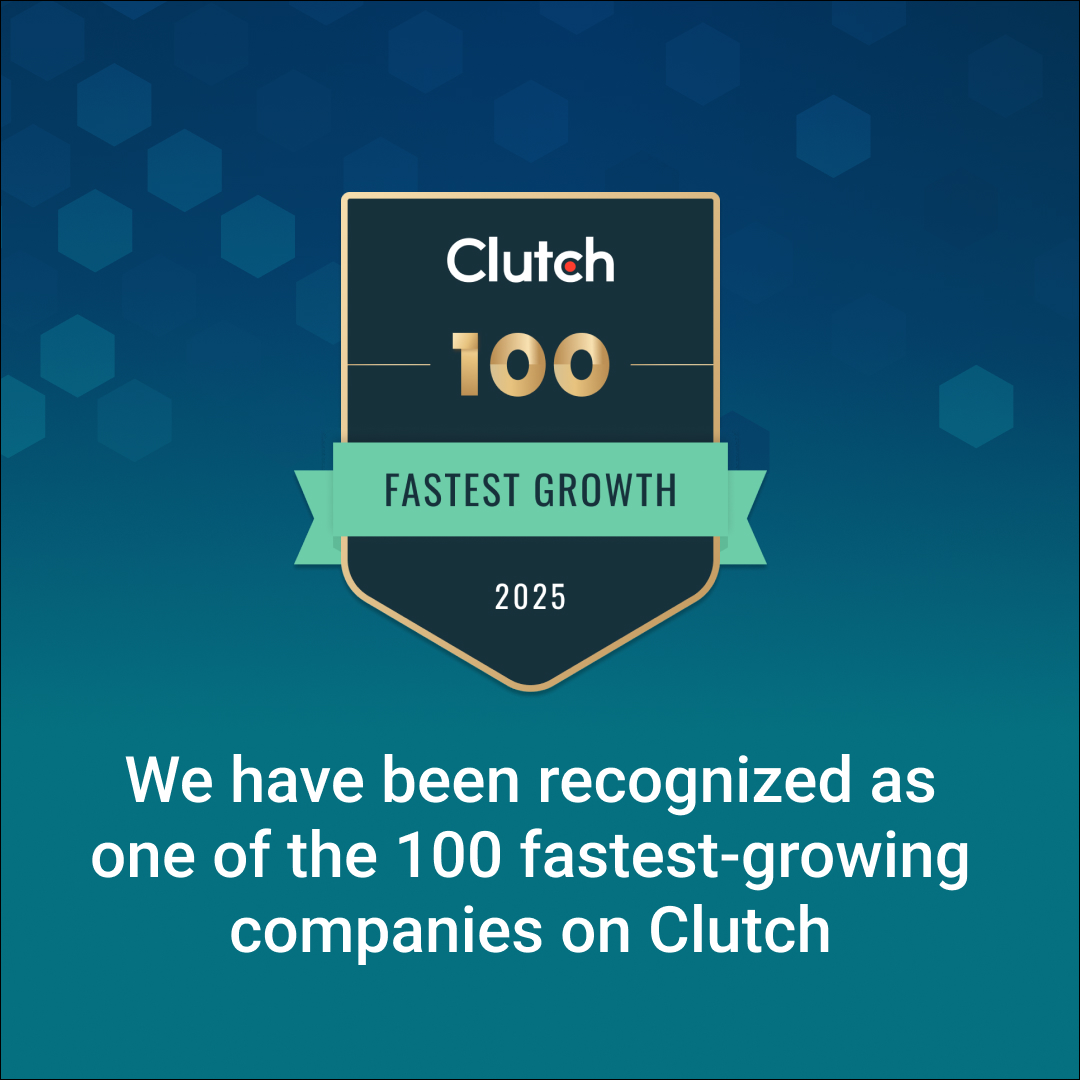Introduction
Advertising is undergoing a seismic shift. With rising customer acquisition costs, fragmented media channels, and the demand for hyper-personalized experiences, traditional methods are falling short. Enter AI: a transformative force that’s redefining how brands create, target, and optimize campaigns. From real-time personalization to fully automated ad production, AI is turning advertising into a precision-driven, scalable engine for growth. This guide explores how AI is revolutionizing advertising—from creative development to performance analytics—offering actionable insights for marketers aiming to stay ahead.
What is AI and Why Does It Matter in Advertising?

Definition of AI and Its Core Technologies
Artificial Intelligence (AI) encompasses computer systems designed to perform tasks that typically require human intelligence, such as learning, reasoning, problem-solving, and decision-making. According to IBM, AI includes technologies that enable machines to sense, comprehend, act, and learn with human-like intelligence. In advertising, AI leverages machine learning, natural language processing (NLP), and computer vision to automate and enhance various aspects of the marketing process. These technologies enable advertisers to analyze vast amounts of data, generate personalized content, and optimize campaign performance in real-time.
Want to explore how AI can transform your sector? Discover real-world strategies for deploying smart technologies in advertising—visit How to Integrate AI into Your Business in 2025 to get started today and unlock the full potential of AI for your business!
The Growing Role of AI in Transforming Advertising
AI is reshaping advertising by enabling real-time personalization and dynamic content creation. For instance, AI algorithms can analyze user behavior and preferences to deliver tailored ads that resonate with individual consumers, thereby increasing engagement and conversion rates. Moreover, AI facilitates the automation of ad buying and placement through programmatic advertising. This allows marketers to efficiently target specific audiences across various platforms, optimizing ad spend and maximizing ROI.
Additionally, AI-driven analytics provide deeper insights into campaign performance, enabling marketers to make data-informed decisions and continuously refine their strategies for better outcomes.
Key Statistics and Trends Highlighting AI Adoption in Advertising
The rise of AI in advertising isn’t speculative-it’s supported by measurable results and clear adoption trends. Here’s what the data is telling us, and what it means for your strategy.
AI adoption is growing fast across the advertising landscape. According to McKinsey’s 2024 Global Marketing Report, AI-driven marketing initiatives have already boosted conversion rates by 10-20% for companies that implemented personalization and real-time analytics. That kind of uplift can directly translate to revenue gains.
Salesforce’s State of Marketing report highlights that 84% of marketers are already using some form of AI, whether it’s for predictive lead scoring, content generation, or ad optimization. More impressively, 61% of those marketers plan to increase their AI budget this year, reflecting rising confidence in its ROI.
The global market for AI in advertising is expected to reach $70.7 billion by 2032, up from just $14.2 billion in 2022, according to Precedence Research. This compound annual growth rate (CAGR) of 17.3% signals not just expansion, but acceleration-and if you’re not on board, you risk being left behind by more agile competitors. Explore how AI is transforming digital marketing beyond advertising.
Business Benefits of AI in Advertising
AI is more than a buzzword–it’s a performance multiplier for your advertising strategy. By addressing persistent pain points like inefficiency, rising costs, and limited personalization, AI creates tangible, measurable value. Below are five powerful ways it can elevate your marketing outcomes.
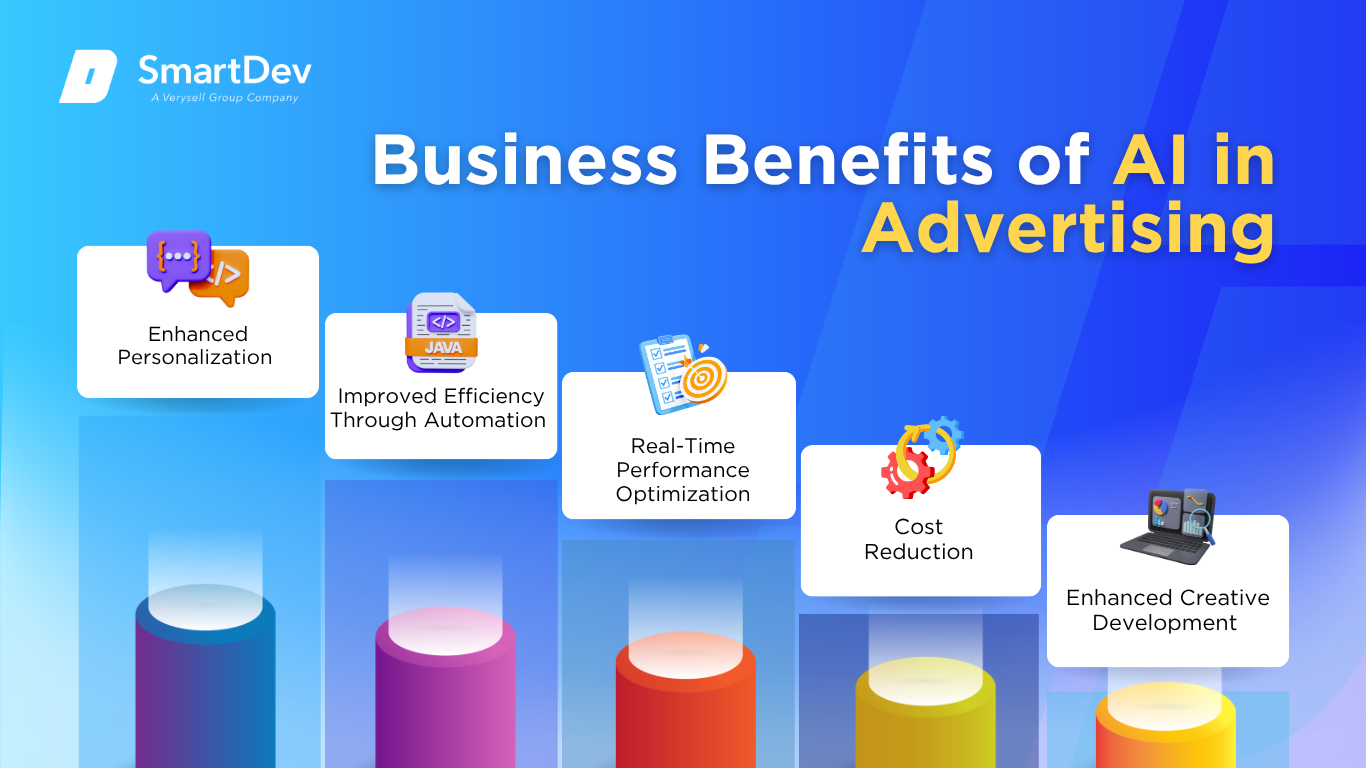
-
Enhanced Personalization
Your audience expects content that feels tailor-made, and AI delivers exactly that. By analyzing user behavior, purchase history, and engagement data, AI tools generate deep insights into individual preferences. This allows you to serve hyper-personalized ads at scale-no more relying on generic messaging that gets lost in the noise.
Take dynamic creative optimization, for instance. It automatically assembles ad components (like headlines, images, and CTAs) in real-time based on the viewer’s profile. The result? Higher click-through rates, better conversion rates, and a more engaging customer experience across platforms.
-
Improved Efficiency Through Automation
Managing ad campaigns across platforms is time-consuming. AI changes that by automating time-intensive processes like media buying, ad placement, and budget allocation. Through programmatic advertising, AI can buy ads in real time based on live auction data and user profiles-so you’re always showing the right ad, at the right time, to the right person.
This not only reduces manual effort but also improves your response speed to performance data. Instead of weekly optimizations, you’re reacting in seconds. That’s how your team moves from reactive to proactive, allowing more time to focus on creative strategy and brand building.
-
Real-Time Performance Optimization
Most campaigns don’t reach their potential because optimization happens too late. With AI, you can identify which creatives, audiences, or channels are underperforming-instantly. Advanced analytics tools continuously learn and adjust, reallocating your spend toward higher-performing assets.
Imagine launching a campaign and having it adjust itself in real time to maximize ROI. That’s not a dream-it’s happening now. You can even run A/B/n tests automatically, letting AI decide which variant resonates best, saving weeks of manual testing and reporting.
-
Cost Reduction
Wasted ad spend is one of the biggest frustrations in marketing. AI tackles this by making every dollar work smarter. Predictive analytics forecast outcomes so you invest only where the return is likely to be strong. Algorithms optimize bids to avoid overspending on impressions that won’t convert.
Moreover, AI minimizes the cost of failed experiments. Instead of investing heavily in a new channel or audience based on guesswork, you use data-driven simulations and forecasts. That’s how you trim fat from your budget while increasing your impact. Explore our AI-Powered Development approach for smarter execution and cost reduction.
-
Enhanced Creative Development
Creativity is still the heart of great advertising-but now it’s augmented by intelligence. AI tools can analyze thousands of successful ad creatives to identify trends and performance patterns. This empowers your team to produce content that aligns with what’s proven to work-without stifling originality.
Tools like ChatGPT or Jasper.ai help copywriters generate first drafts, headlines, or calls to action. Meanwhile, platforms like Canva and Adobe Sensei assist in designing compelling visuals based on performance metrics. You maintain creative control while gaining powerful insights that shape content strategy.
Want to see how this works across industries? See how AI Redefining Success: How AI-Driven Marketing Analytics is Revolutionizing Campaign Performance
Challenges Facing AI Adoption in Advertising
AI brings transformative capabilities–but integrating it into your ad strategy isn’t always smooth. There are real obstacles that need to be navigated with clear–eyed planning and collaboration. Below are five of the most pressing challenges and how they affect your operations.
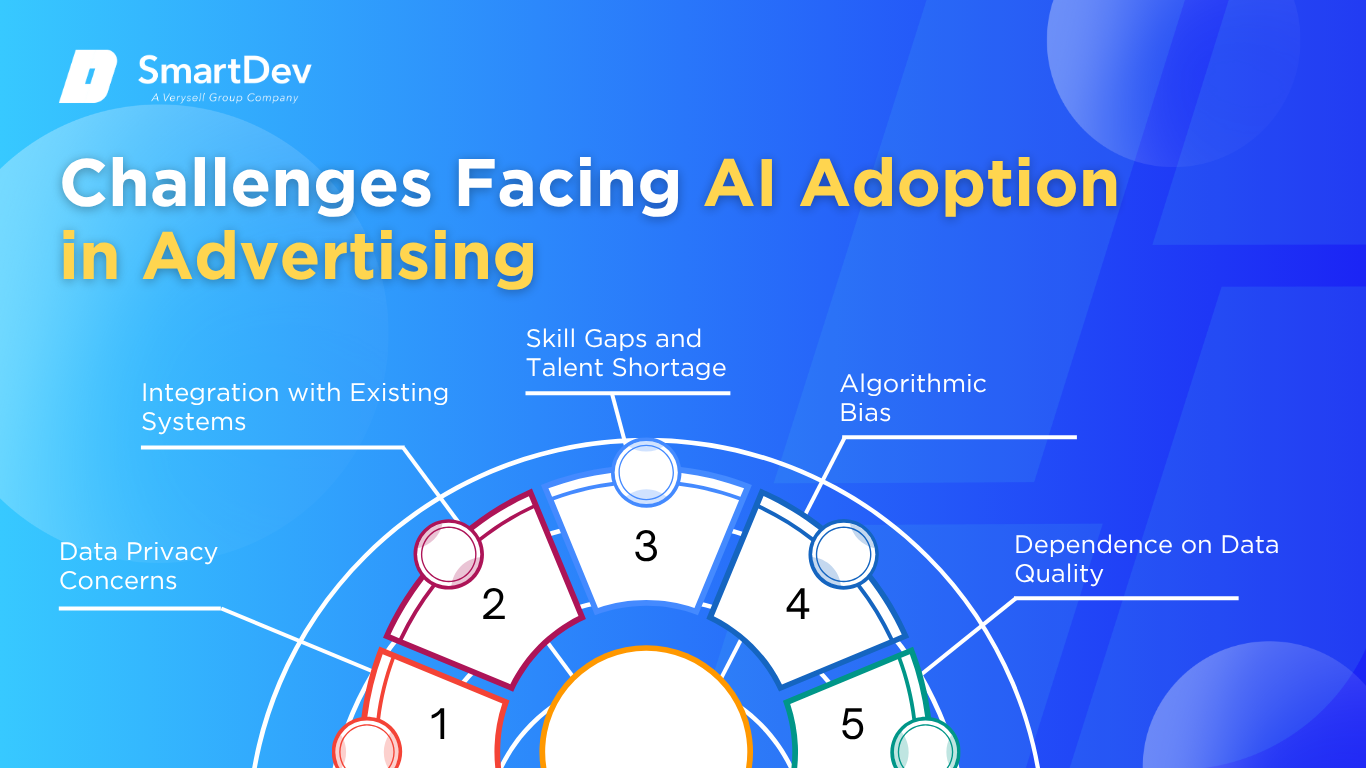
-
Data Privacy Concerns
Consumers are more conscious than ever about how their data is used. With AI relying on vast amounts of personal data to fuel personalization and targeting, staying compliant with privacy regulations like GDPR and CCPA becomes critical. Missteps can erode trust-and result in hefty fines.
You’ll need to ensure your data collection practices are transparent and obtain explicit consent for AI-based personalization. More importantly, you must continuously audit how AI handles sensitive data, ensuring ethical and secure usage to protect your brand’s integrity.
-
Integration with Existing Systems
Many businesses find that their existing martech stack isn’t ready for AI. Legacy systems often lack the flexibility to connect with new AI tools, leading to siloed data and fragmented workflows. If your systems can’t talk to each other, your AI can’t function effectively.
To get the full value of AI, you may need to upgrade platforms or invest in middleware that unifies your tech ecosystem. It’s not just an IT task-marketing, sales, and IT must collaborate to build an agile, future-proof infrastructure that supports real-time intelligence.
-
Skill Gaps and Talent Shortage
You might have the tools-but do you have the people who know how to use them? AI success hinges on having the right talent: data scientists, machine learning engineers, and marketers fluent in analytics. Unfortunately, the talent pool is thin, and competition is fierce.
If building an internal team isn’t feasible, consider partnerships with specialized agencies or tech vendors. Additionally, prioritize upskilling your existing team through training and certifications so they can adapt and thrive in an AI-driven landscape.
-
Algorithmic Bias
AI is only as good as the data it learns from. If that data contains historical biases-whether related to gender, race, or location-those biases will show up in your ads. That’s not just bad for performance; it can damage your brand and alienate key segments.
Combatting bias requires deliberate action. Use diverse training datasets, audit algorithms regularly, and build a governance model for your AI use. By fostering ethical AI, you not only protect your brand but also promote fairness and inclusion in your messaging. To address this problem, the providers need to understand deeply, so you can read Addressing AI Bias and Fairness: Challenges, Implications, and Strategies for Ethical AI.
-
Dependence on Data Quality
AI thrives on data-but not just any data. Inaccurate, outdated, or inconsistent data will produce misleading insights, poorly targeted ads, and inefficient budgets. That’s why data quality isn’t just a technical issue-it’s a strategic imperative.
You need a robust data governance framework that includes cleansing, validation, and ongoing monitoring. Ownership of data hygiene should be shared across marketing, sales, and IT, ensuring your AI engine runs on the cleanest fuel possible.
Specific Applications of AI in Advertising
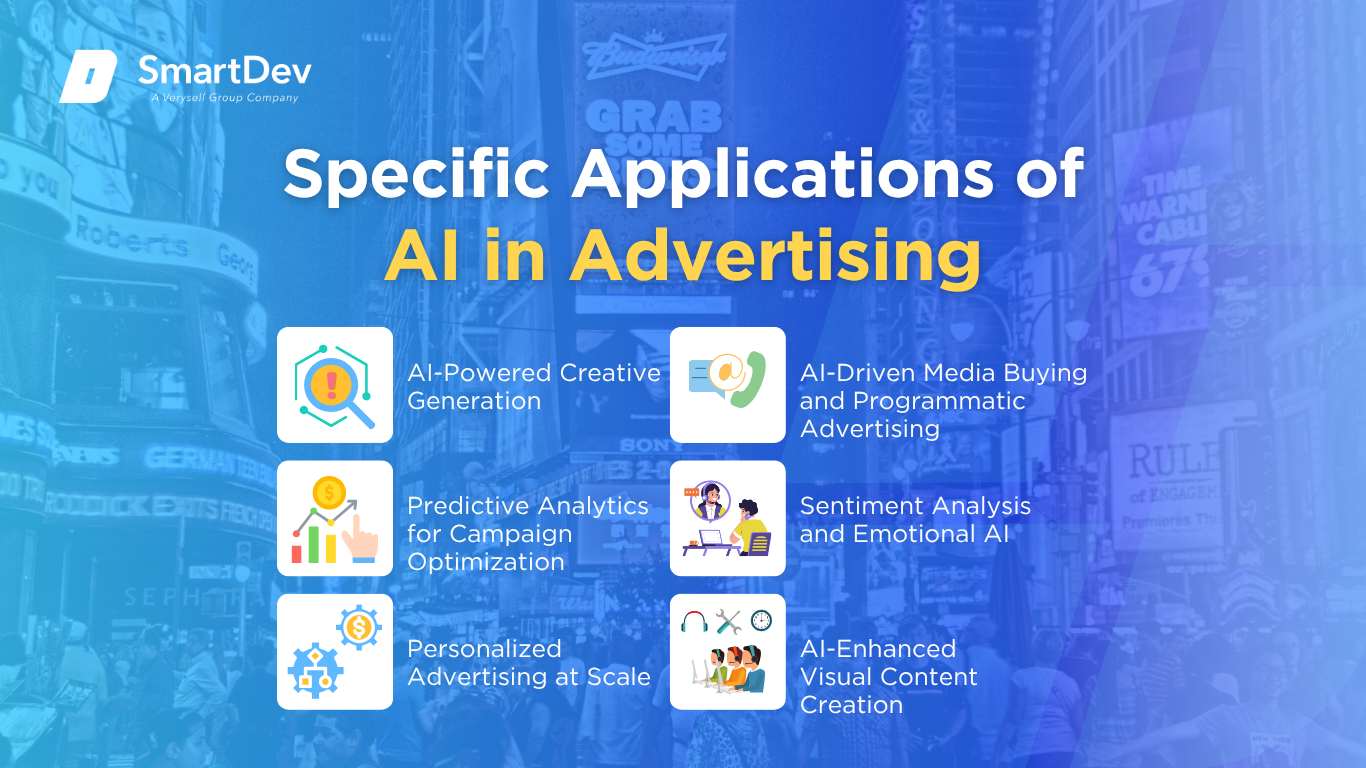
-
AI-Powered Creative Generation
AI-powered creative generation automates the creation of ad content, including images, videos, and copy. This addresses the challenge of producing high-quality, engaging content at scale, reducing the reliance on manual processes.
These systems leverage generative AI models trained on vast datasets to produce content that aligns with brand guidelines and audience preferences. By analyzing existing successful ads and user engagement metrics, AI can generate new creatives that resonate with target audiences.
The strategic value lies in the ability to rapidly produce diverse content variations, facilitating A/B testing and personalization. This accelerates campaign deployment and enhances performance by delivering more relevant ads to consumers.
Check out how generative AI supports scalable content production for startups and enterprises
Real-World Example:
Meta Platforms plans to fully automate ad creation and targeting using AI by the end of 2026. Advertisers will input basic information-such as a product image and budget-and the AI will generate complete campaigns, including visuals, text, and targeting strategies for Facebook and Instagram. This initiative aims to simplify advertising processes, particularly benefiting small and midsize businesses lacking in-house creative resources.
-
Predictive Analytics for Campaign Optimization
Predictive analytics utilizes AI to forecast campaign outcomes, enabling advertisers to make data-driven decisions. This addresses the challenge of optimizing campaigns for maximum ROI amidst complex consumer behaviors.
AI models analyze historical data, market trends, and consumer interactions to predict future performance. Machine learning algorithms identify patterns and correlations, informing adjustments in targeting, budgeting, and creative strategies.
The operational value includes improved allocation of resources, enhanced targeting precision, and increased campaign effectiveness. Predictive insights allow for proactive adjustments, reducing waste and maximizing impact.
Real-World Example:
Delta Air Lines employed AI technology to optimize ad performance and connect advertising with sales data. Using Alembic’s spiking neural network, Delta attributed $30 million in sales to its Olympic sponsorship, demonstrating the power of AI in linking marketing efforts to tangible business outcomes.
-
Personalized Advertising at Scale
Personalized advertising delivers tailored messages to individual consumers, enhancing engagement and conversion rates. AI addresses the challenge of scaling personalization across large, diverse audiences.
Machine learning algorithms analyze user data, including browsing history, purchase behavior, and demographic information, to create detailed customer profiles. These profiles inform the delivery of customized content that aligns with individual preferences.
The strategic advantage lies in fostering deeper customer connections, increasing relevance, and driving higher conversion rates. Personalization also improves customer satisfaction and loyalty by providing more meaningful interactions.
Real-World Example:
Sephora utilizes AI-powered chatbots to provide personalized product recommendations and support. By analyzing customer data and preferences, the AI delivers tailored suggestions, enhancing the shopping experience and boosting sales.
-
AI-Driven Media Buying and Programmatic Advertising
AI-driven media buying automates the purchasing of ad space, optimizing placements in real-time. This addresses the complexity and speed required in modern advertising environments.
Programmatic advertising platforms use AI to analyze vast amounts of data, determining the most effective channels, times, and formats for ad placements. Real-time bidding algorithms ensure optimal pricing and audience targeting.
The operational benefits include increased efficiency, reduced costs, and improved targeting accuracy. AI enables dynamic adjustments to campaigns, ensuring ads reach the right audience at the right time.
Real-World Example:
RTB House employs deep learning algorithms for personalized retargeting, analyzing user behavior to deliver relevant ads. Their technology has improved campaign effectiveness by 41-50% compared to traditional methods, showcasing AI’s impact on programmatic advertising.
-
Sentiment Analysis and Emotional AI
Sentiment analysis and emotional AI interpret consumer emotions and opinions, providing insights into brand perception. This addresses the need for understanding audience reactions beyond traditional metrics.
AI models process text, voice, and facial expressions to gauge sentiment and emotional responses. These insights inform content creation, customer service, and crisis management strategies.
The strategic value includes enhanced brand reputation management, improved customer experiences, and more resonant messaging. Understanding emotional responses allows brands to connect with audiences on a deeper level.
Real-World Example:
Affectiva’s Emotion AI technology analyzes facial expressions and vocal intonations to detect consumer emotions. Brands use this data to assess ad effectiveness and refine content to better engage audiences.
-
AI-Enhanced Visual Content Creation
AI-enhanced visual content creation automates the development of images and videos, addressing the demand for high-quality visuals in advertising.
Generative AI tools produce visuals that align with brand aesthetics and campaign goals. These tools can create content from scratch or enhance existing assets, streamlining the creative process.
The operational benefits include faster production times, cost savings, and the ability to generate a wide variety of content. AI enables rapid iteration and adaptation to different platforms and audiences.
Real-World Example:
Waymark, a company specializing in AI-generated video commercials, has partnered with major media companies like CBS and Fox TV Stations. Their platform allows for the quick creation of professional-quality video ads, enhancing efficiency and scalability in advertising campaigns.
Examples of AI in Advertising
Real-World Case Studies
Real-world applications of AI in advertising demonstrate its transformative impact across various aspects of marketing. Let’s delve into three notable case studies that highlight the challenges faced, solutions implemented, and outcomes achieved through AI integration.
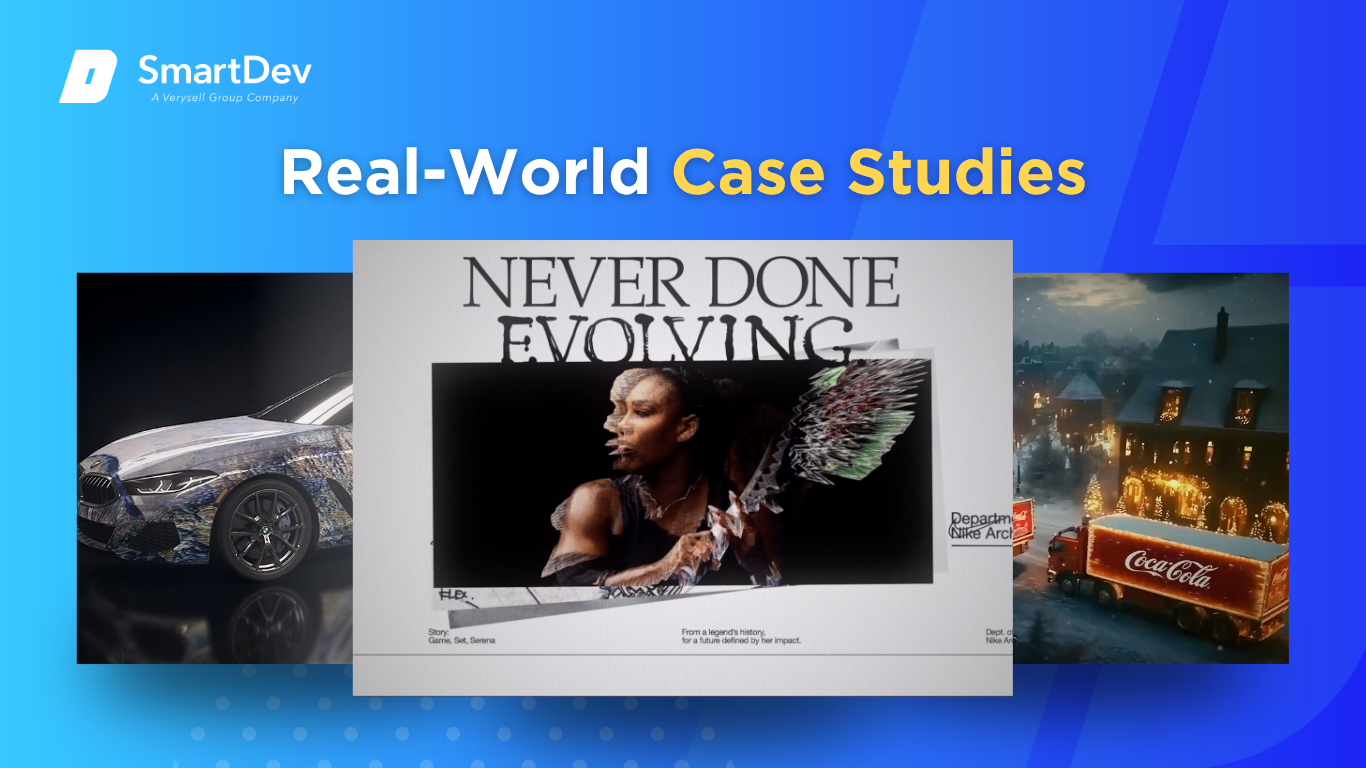
1. Nike: “Never Done Evolving” – A Virtual Match Across Time
In celebration of its 50th anniversary and Serena Williams’ illustrious career, Nike embarked on an ambitious project: to create a virtual tennis match between Serena’s 1999 and 2017 selves. The challenge was to authentically simulate the playing styles of both versions of Serena, capturing the nuances of her evolution as an athlete. This required analyzing extensive archival footage and translating it into a dynamic, engaging narrative.
Collaborating with AKQA, Nike utilized advanced machine learning to model Serena’s decision-making, shot selection, and agility from different eras. The AI processed data from over 130,000 games, generating realistic simulations that were then rendered into a compelling visual experience. The campaign not only paid homage to Serena’s legacy but also showcased AI’s potential in storytelling.
The outcome was remarkable: the campaign broke Nike’s organic view records on YouTube, achieving a 1,082% increase in views compared to previous content. It received widespread acclaim, including the Digital Craft Grand Prix at Cannes Lions 2023, and set a new standard for integrating AI into creative advertising.
2. BMW: Generative AI Enhancing Operational Efficiency
BMW faced the complex challenge of streamlining its cloud incident analysis process, which traditionally involved time-consuming root cause analyses across multiple software components. The need was for a solution that could quickly and accurately identify issues to maintain high availability of digital services.
To address this, BMW implemented a generative AI solution using Amazon Bedrock Agents. This AI-driven approach automated the root cause analysis process, achieving an 85% accuracy rate in identifying issues. The system provided real-time insights, significantly reducing diagnosis times and enhancing system understanding for engineers.
The implementation of this AI solution led to a substantial increase in operational efficiency. Engineers could resolve incidents more swiftly, minimizing downtime and improving the overall reliability of BMW’s digital services. This case exemplifies how AI can be leveraged to optimize complex operational processes in the automotive industry.
3. Coca-Cola: AI-Generated Holiday Campaign – A Cautionary Tale
Coca-Cola ventured into AI-generated advertising by reimagining its iconic “Holidays Are Coming” campaign using AI technology. The goal was to modernize the classic ad and connect with a new generation of consumers. However, the execution faced criticism for lacking the emotional warmth and authenticity of the original.
The AI-generated ads featured digitally created visuals of Coca-Cola trucks and festive scenes. Despite the technological innovation, many viewers found the ads to be “soulless” and “creepy,” highlighting the limitations of AI in capturing human emotion and nostalgia.
This experience underscores the importance of balancing technological advancement with emotional resonance in advertising. While AI offers efficiency and scalability, it must be complemented by human creativity to maintain the authenticity that consumers value.
These examples highlight the value of working with partners who understand both the technical demands of AI and the unique expectations of today’s advertising planners. If you’re considering AI for your advertising business, collaborating with experienced specialists can help unlock smart, scalable solutions tailored to your customer journey.
Innovative AI Solutions
Emerging AI technologies are continuously reshaping the advertising landscape, offering new tools and capabilities. Let’s explore some of these innovations and their implications for the industry.
1. Generative Adversarial Networks (GANs)
GANs have revolutionized content creation by enabling the generation of highly realistic images and videos. In advertising, GANs are used to create virtual models, simulate environments, and produce product images, reducing the need for costly photoshoots and allowing for rapid content development.
For instance, fashion brands utilize GANs to generate diverse model images, showcasing clothing lines without the logistical challenges of traditional photography. This not only accelerates the content creation process but also allows for greater customization and personalization in marketing materials.
2. Natural Language Processing (NLP)
NLP enables machines to understand and generate human language, facilitating more natural interactions between brands and consumers. In advertising, NLP powers chatbots, personalized email campaigns, and dynamic ad copy, enhancing customer engagement and experience.
By analyzing customer inquiries and feedback, NLP-driven systems can tailor responses and content to individual preferences, fostering a more personalized connection with the audience. This leads to increased customer satisfaction and loyalty.
3. AI-Powered Analytics Platforms
Advanced analytics platforms leveraging AI provide deeper insights into campaign performance, consumer behavior, and market trends. These tools enable marketers to make informed decisions, optimize strategies, and predict future outcomes with greater accuracy.
For example, AI analytics can identify which ad creatives resonate most with specific demographics, allowing for targeted adjustments that enhance campaign effectiveness. This data-driven approach ensures resources are allocated efficiently, maximizing return on investment.
By embracing these innovative AI solutions, advertisers can enhance creativity, efficiency, and personalization in their campaigns. As AI continues to evolve, its integration into advertising strategies will be crucial for staying competitive in the dynamic marketing landscape.
AI-Driven Innovations Transforming Advertising
Emerging AI technologies are continuously reshaping the advertising landscape, offering new tools and capabilities. Let’s explore some of these innovations and their implications for the industry.
1. Generative Adversarial Networks (GANs)
GANs have revolutionized content creation by enabling the generation of highly realistic images and videos. In advertising, GANs are used to create virtual models, simulate environments, and produce product images, reducing the need for costly photoshoots and allowing for rapid content development.
For instance, fashion brands utilize GANs to generate diverse model images, showcasing clothing lines without the logistical challenges of traditional photography. This not only accelerates the content creation process but also allows for greater customization and personalization in marketing materials.
2. Natural Language Processing (NLP)
NLP enables machines to understand and generate human language, facilitating more natural interactions between brands and consumers. In advertising, NLP powers chatbots, personalized email campaigns, and dynamic ad copy, enhancing customer engagement and experience.
By analyzing customer inquiries and feedback, NLP-driven systems can tailor responses and content to individual preferences, fostering a more personalized connection with the audience. This leads to increased customer satisfaction and loyalty.
3. AI-Powered Analytics Platforms
Advanced analytics platforms leveraging AI provide deeper insights into campaign performance, consumer behavior, and market trends. These tools enable marketers to make informed decisions, optimize strategies, and predict future outcomes with greater accuracy.
For example, AI analytics can identify which ad creatives resonate most with specific demographics, allowing for targeted adjustments that enhance campaign effectiveness. This data-driven approach ensures resources are allocated efficiently, maximizing return on investment.
By embracing these innovative AI solutions, advertisers can enhance creativity, efficiency, and personalization in their campaigns. As AI continues to evolve, its integration into advertising strategies will be crucial for staying competitive in the dynamic marketing landscape.
How to Implement AI in Advertising
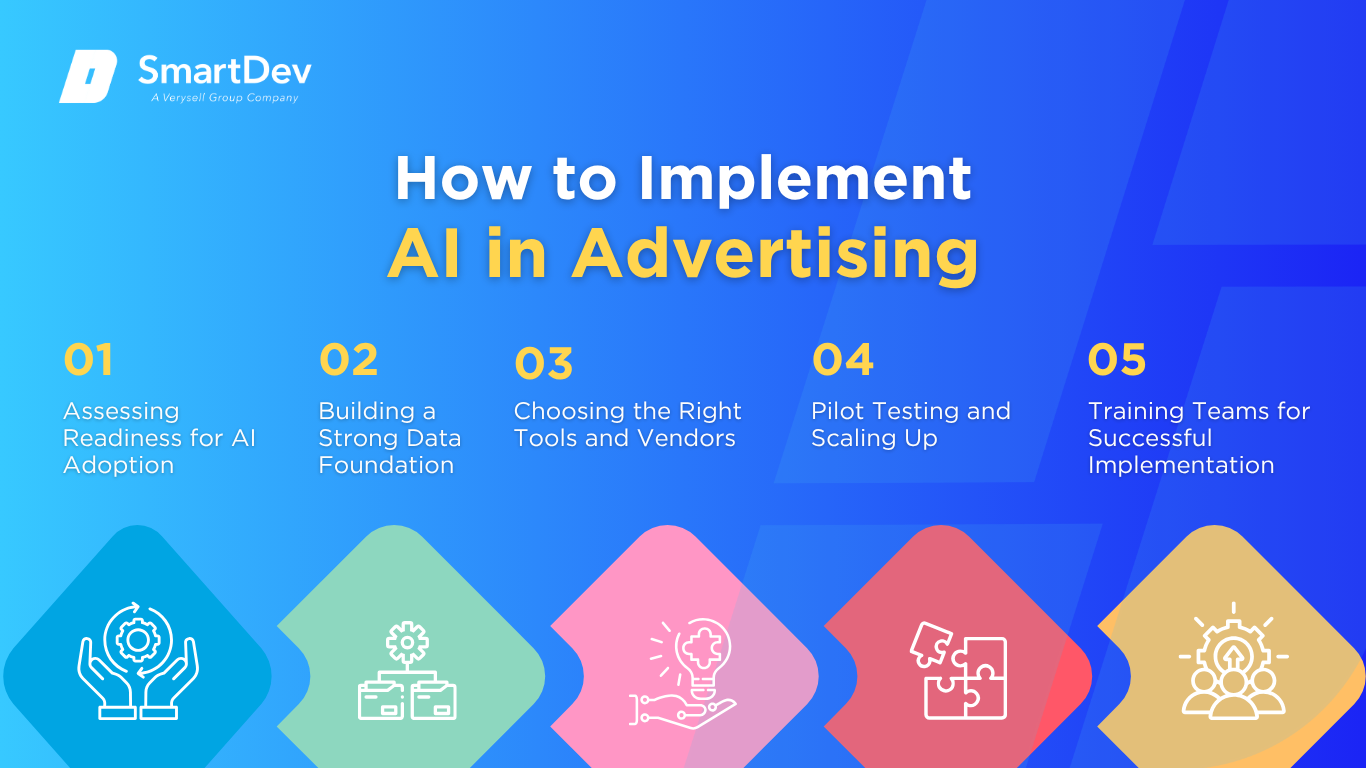
-
Assessing Readiness for AI Adoption
Before integrating AI into advertising strategies, businesses must assess their readiness for such a transformation. This involves evaluating existing processes, identifying areas where AI can add value, and determining the resources required for implementation. Companies should start by pinpointing repetitive and data-intensive tasks that can be automated, such as audience segmentation, ad placement, and performance analysis.
Additionally, it’s essential to consider the organization’s culture and willingness to embrace technological change. Engaging stakeholders across departments and providing education on the benefits and implications of AI can facilitate smoother adoption. By thoroughly assessing readiness, businesses can develop a strategic roadmap for AI integration that aligns with their goals and capabilities.
-
Building a Strong Data Foundation
A robust data infrastructure is the backbone of successful AI implementation in advertising. This entails collecting high-quality, relevant data from various sources, including customer interactions, website analytics, and social media engagements. Ensuring data accuracy and consistency is paramount, as AI algorithms rely on this information to make informed decisions.
Data management practices should include regular cleaning to remove duplicates and errors, as well as establishing protocols for data privacy and compliance with regulations like GDPR. Investing in data management tools and skilled personnel can enhance the organization’s ability to harness AI effectively. With a solid data foundation, businesses can unlock the full potential of AI to drive targeted and impactful advertising campaigns.
-
Choosing the Right Tools and Vendors
Selecting appropriate AI tools and vendors is critical to the success of AI-driven advertising initiatives. Businesses should evaluate potential solutions based on their specific needs, scalability, ease of integration, and support services. It’s important to choose tools that offer transparency in their algorithms and allow for customization to align with brand values and objectives.
Collaborating with reputable vendors who have a proven track record in AI advertising can provide access to cutting-edge technology and industry expertise. Engaging in pilot programs or requesting case studies can offer insights into the tool’s performance and suitability for the business. By carefully selecting tools and partners, companies can ensure a smoother transition to AI-enhanced advertising strategies.
-
Pilot Testing and Scaling Up
Implementing AI in advertising should begin with pilot testing to evaluate effectiveness and identify potential challenges. Starting with a specific campaign or segment allows businesses to monitor performance metrics, gather feedback, and make necessary adjustments. This iterative approach facilitates learning and minimizes risks associated with large-scale deployment.
Once the pilot demonstrates positive results, businesses can gradually scale up AI integration across broader campaigns and channels. Continuous monitoring and optimization are essential to adapt to changing market dynamics and consumer behaviors. By adopting a phased approach, companies can build confidence in AI technologies and ensure sustainable growth in their advertising efforts.
-
Training Teams for Successful Implementation
Equipping teams with the necessary skills and knowledge is vital for the successful adoption of AI in advertising. This involves providing training on AI tools, data analysis, and interpreting AI-generated insights. Encouraging cross-functional collaboration between marketing, IT, and data science teams can foster a holistic understanding of AI’s role in advertising.
Moreover, cultivating a culture of continuous learning and innovation empowers employees to embrace AI-driven changes proactively. Offering workshops, certifications, and access to learning resources can enhance the team’s capabilities and confidence in utilizing AI effectively. By investing in human capital, businesses can maximize the benefits of AI and drive impactful advertising outcomes.
Measuring the ROI of AI in Advertising
-
Key Metrics to Track Success
Evaluating the return on investment (ROI) of AI in advertising requires tracking specific metrics that reflect performance improvements and cost efficiencies. Key indicators include conversion rates, customer acquisition costs, click-through rates, and overall campaign ROI. Monitoring these metrics before and after AI implementation can provide insights into the technology’s impact on advertising effectiveness.
Additionally, assessing customer engagement levels, such as time spent on ads and interaction rates, can reveal the quality of AI-driven personalization. Analyzing these data points enables businesses to refine their strategies, allocate resources more effectively, and justify investments in AI technologies.
-
Case Studies Demonstrating ROI
Several companies have reported significant ROI improvements through AI-driven advertising strategies. For instance, Headway, a Ukrainian edtech startup, utilized AI tools like Midjourney and HeyGen to enhance its ad performance. This approach led to a 40% increase in ROI for video ads, reaching 3.3 billion impressions in the first half of 2024.
Similarly, Delta Air Lines employed AI technology to optimize ad performance and connect advertising with sales data. By using Alembic’s spiking neural network, Delta attributed $30 million in sales to its Olympic sponsorship, showcasing the tangible benefits of AI in advertising.
Understanding ROI is possibly a challenge to many businesses and institutions as different in background, cost. So, if you need to dig deep about this problem, you can read AI Return on Investment (ROI): Unlocking the True Value of Artificial Intelligence for Your Business
-
Common Pitfalls and How to Avoid Them
While AI offers numerous advantages, businesses may encounter challenges during implementation. Common pitfalls include data privacy concerns, over-reliance on automation, and lack of transparency in AI algorithms. To mitigate these issues, companies should establish clear data governance policies, maintain human oversight in decision-making processes, and select AI tools that offer explainability.
Additionally, setting realistic expectations and understanding that AI is a tool to augment, not replace, human creativity can prevent disillusionment. Continuous evaluation and adaptation are crucial to address evolving challenges and ensure the sustainable success of AI-driven advertising initiatives.
Future Trends of AI in Advertising
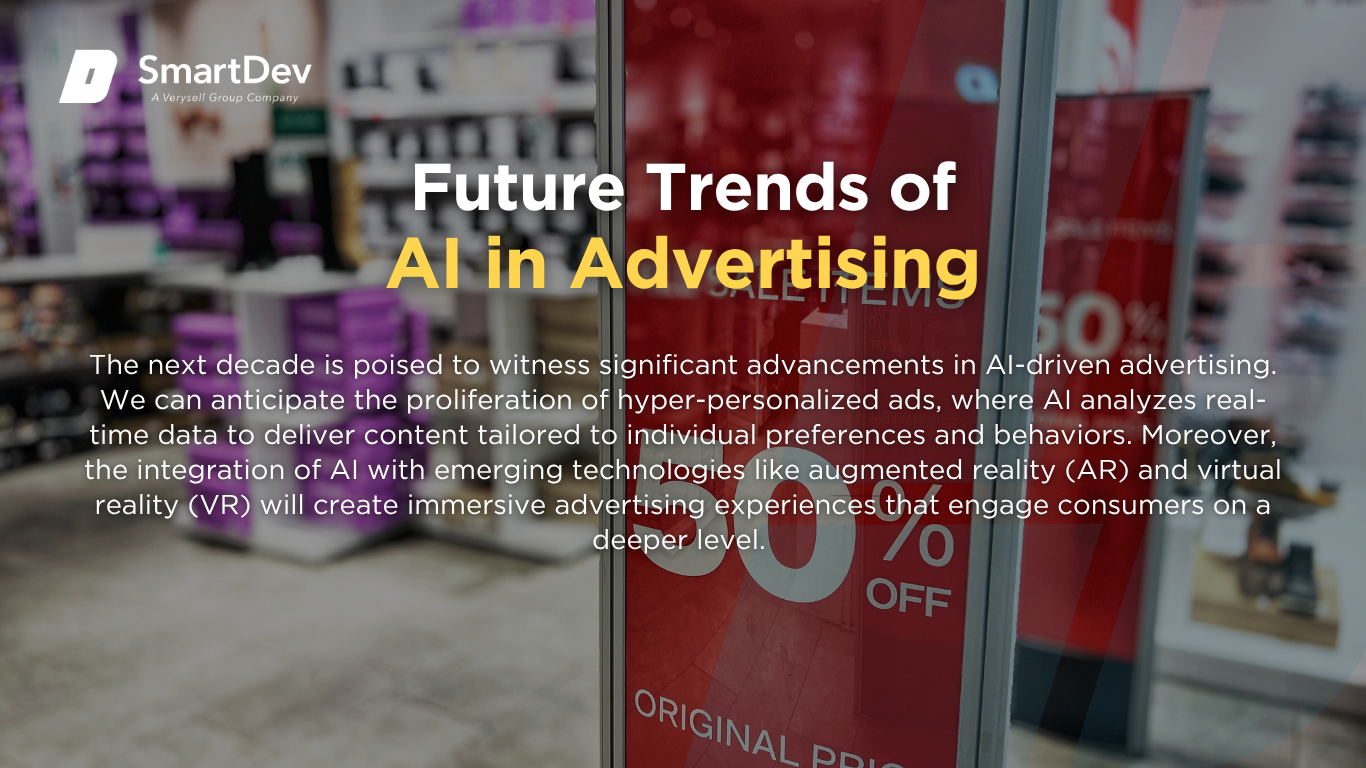
-
Predictions for the Next Decade
The next decade is poised to witness significant advancements in AI-driven advertising. We can anticipate the proliferation of hyper-personalized ads, where AI analyzes real-time data to deliver content tailored to individual preferences and behaviors. Moreover, the integration of AI with emerging technologies like augmented reality (AR) and virtual reality (VR) will create immersive advertising experiences that engage consumers on a deeper level.
Furthermore, ethical considerations and regulatory frameworks will shape the development and deployment of AI in advertising. Companies will need to balance innovation with responsibility, ensuring transparency, fairness, and respect for consumer privacy. By staying attuned to these trends, businesses can harness AI’s potential to revolutionize advertising while maintaining public trust.
-
How Businesses Can Stay Ahead of the Curve
To remain competitive in the evolving landscape of AI-driven advertising, businesses must adopt a proactive and adaptive approach. This involves investing in continuous learning, fostering a culture of innovation, and staying informed about technological advancements and regulatory changes. Collaborating with AI experts, participating in industry forums, and engaging in pilot projects can provide valuable insights and keep companies at the forefront of innovation.
Additionally, prioritizing ethical considerations and consumer trust will be paramount. Implementing transparent AI practices, obtaining informed consent for data usage, and ensuring inclusivity in AI algorithms can differentiate businesses in a crowded market. By embracing these strategies, companies can leverage AI to create impactful, responsible, and future-ready advertising campaigns.
Conclusion
Key Takeaways
Artificial intelligence is reshaping the advertising industry by automating processes, enhancing personalization, and driving significant ROI improvements. From generative AI tools that streamline ad creation to predictive analytics that optimize ad targeting, AI technologies are delivering measurable value across the advertising landscape.
The implementation of AI enables businesses to create more engaging, efficient, and sustainable advertising campaigns by leveraging data-driven insights and reducing waste. As demonstrated through real-world examples, companies that have embraced AI are already reaping the rewards, including improved conversion rates, increased revenue, and greater operational efficiency.
Equally important is the thoughtful and strategic approach to AI integration. Businesses must evaluate their readiness, invest in a strong data infrastructure, choose the right tools, and train their teams to ensure successful adoption. Moreover, continuous monitoring of key performance metrics and adapting to new challenges will be essential for maximizing the long-term benefits of AI.
Moving Forward: A Path to Progress
If you’re in the advertising industry and looking to stay competitive in an increasingly digital world, now is the time to explore AI-driven solutions.
Start by identifying pain points in your current campaigns where AI could make an impact—whether it’s through automating ad creation, refining audience segmentation, or enhancing real-time performance analytics.
Collaborate with trusted vendors, invest in training your marketing teams, and consider launching pilot programs to test the waters.
The path to AI adoption may seem complex, but the potential rewards are undeniable.
With the right strategy, tools, and mindset, your organization can harness the power of AI to transform your advertising efforts, achieve greater ROI, and position your brand at the forefront of innovation.
Don’t just keep up with the future—lead it.
—
References:
- How AI Is Revolutionizing Digital Advertising In 2024
- AI Advertising: How AI is Transforming Ad Strategies
- How AI is driving advertising innovation: 8 game-changing trends in 2025
- AI in Advertising: Everything You Need to Know
- AI-powered Advertising and Marketing Solutions
- 11 Best AI Advertising Examples of 2025
- AI in Advertising: Use Cases, Benefits, & Challenges


